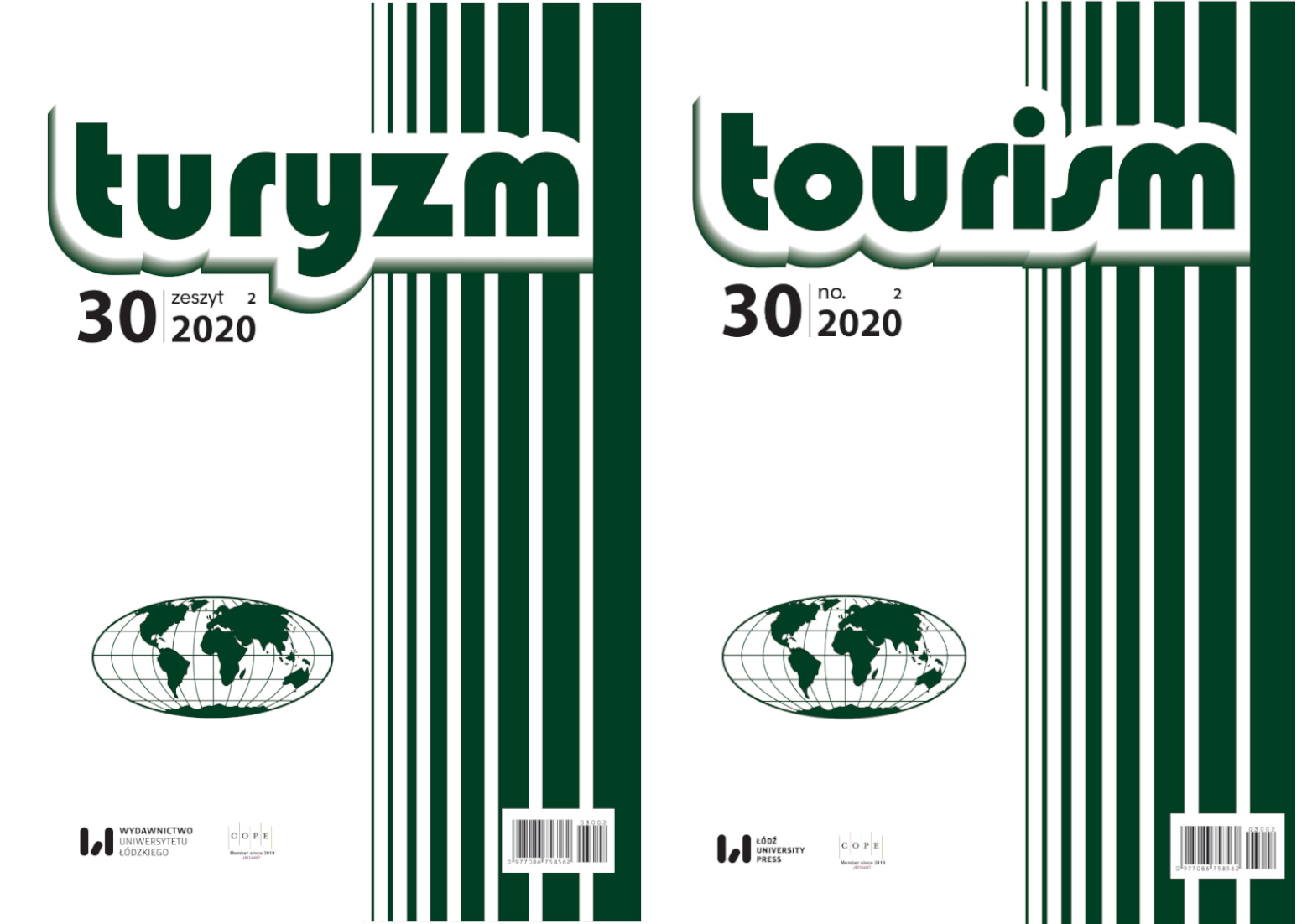Fanoturystyka i fanoturysta – głos w dyskusji nad definicjami i problematyką badawczą
DOI:
https://doi.org/10.18778/0867-5856.30.2.04Keywords:
fanoturystyka, fanoturysta, turystyka sportowa, turystyka kulturowa, fan, fanatyk, kibicAbstract
Celem artykułu jest usystematyzowanie pojęć związanych z fanoturystyką i fanoturystą. Autorki opracowania podjęły także próbę sporządzenia profilu fanoturysty. Poprzez własne rozważania chcą wypełnić lukę badawczą w definiowaniu tego pojęcia. W pracy zastosowano metodę analizy, krytyki piśmiennictwa oraz syntezy. W artykule zaprezentowano charakterystykę fanoturystyki i opis fanoturysty, stworzony z wykorzystaniem zidentyfikowanych na podstawie przeglądu literatury kryteriów psychologicznych, społecznych oraz ekonomicznych. Autorki wyróżniły następujące atrybuty fanoturysty: główna motywacja do działania, zaangażowanie emocjonalne, radykalizm wsparcia, wierność idei, sympatia dla idei, uczestnictwo w widowisku oraz charakter klienta i prosumenta, w sytuacji gdy fanoturysta osobiście bierze udział w wydarzeniu. W procesie wyodrębniania cech fanoturysty zostały użyte pojęcia fana, fanatyka i kibica.
Downloads
References
Alejziak, W. (2016). Turystyka sportowa – przyczynek do dyskusji nad definicją oraz problematyką badawczą. Turyzm/Tourism, 26 (1), 91–94. DOI: https://doi.org/10.18778/0867-5856.26.1.10
Google Scholar
DOI: https://doi.org/10.18778/0867-5856.26.1.10
Beeton, S. (2005). Film-induced tourism. Clevedon: Channel View Publications. DOI: https://doi.org/10.21832/9781845410162
Google Scholar
DOI: https://doi.org/10.21832/9781845410162
Billig, M. (2008). Banalny nacjonalizm. Kraków: Wydawnictwo Znak.
Google Scholar
Brumm, K. (2012). Fanoturystyka. Kibice sportowi w pozytywnym świetle. Poznań: K&AK.M.A. Karasiak.
Google Scholar
Buczkowska, K. (2008). Turystyka kulturowa. Przewodnik metodyczny. Poznań: Akademia Wychowania Fizycznego im. Eugeniusza Piaseckiego w Poznaniu.
Google Scholar
Cho, H., Joo, D., Chi, C. (2019). Examining nostalgia in sport tourism: The case of US college football fans. Tourism Management Perspectives, 29, 97–104. DOI: https://doi.org/10.1016/j.tmp.2018.11.002
Google Scholar
DOI: https://doi.org/10.1016/j.tmp.2018.11.002
Couldry, N. (2007). On the set of the sopranos: ‘Inside’ a fan’s construc-tion of nearness. W: J. Gray, C. Sandvoss, C. L. Harrington (red.), Fandom: Identities and communities in a mediated world (s. 139–148). Nowy Jork: Nowy Jork University Press.
Google Scholar
Długosz-Kurczabowa, K. (2008). Wielki słownik etymologiczno-historyczny języka polskiego. Warszawa: Wydawnictwo Naukowe PWN.
Google Scholar
Dotson, M.J., Clark, J.D., Suber, M.B., Dave, D.S. (2013). Millennials’ perceptions of spectator sports. Services Marketing Quarterly, 34 (3), 215–230. DOI: https://doi.org/10.1080/15332969.2013.798196
Google Scholar
DOI: https://doi.org/10.1080/15332969.2013.798196
Dudała, J. (2004). Fani-chuligani. Rzecz o polskich kibolach. Studium socjologiczne. Warszawa: Wydawnictwo Akademickie Żak.
Google Scholar
Fan (2020a). Pobrane z: https://dictionary.cambridge.org/pl/dictionary/english/fan (1.02.2020).
Google Scholar
Fan (2020b). Pobrane z: https://sjp.pwn.pl/szukaj/fan.html (1.02.2020).
Google Scholar
Fanatyk (2020). Pobrane z: https://sjp.pwn.pl/sjp/fanatyk;2557478.html (1.02.2020).
Google Scholar
Florek, M., Breitbarth, T., Conejo, F. (2008). Mega event = mega impact? Travelling fans’ experience and perceptions of the 2006 FIFA World Cup host nation. Journal of Sport & Tourism, 13 (3), 1–20. DOI: https://doi.org/10.1080/14775080802310231
Google Scholar
DOI: https://doi.org/10.1080/14775080802310231
Forest, F. (1991). 50 podstawowych pojęć kultury współczesnej. Wyjaśnienia i komentarze. Pobrane z: http://docplayer.pl/68734087-50-podstawowych-pojec-kultury-wspolczesnej.html (1.02.2020).
Google Scholar
Geraghty, L. (2014). It’s not all about the music: Online fan communities and collecting Hard Rock Café pins. Transformative Works and Cultures, 16. DOI: https://doi.org/10.3983/twc.2014.0492
Google Scholar
DOI: https://doi.org/10.3983/twc.2014.0492
Geraghty, L. (2018). Passing through: Popular media tourism, pilgrimage and narratives of being a fan. W: C. Lundberg, V. Ziakas (red.), The Routledge handbook of popular culture and tourism. Nowy Jork: Taylor & Francis Group. DOI: https://doi.org/10.4324/9781315559018-19
Google Scholar
DOI: https://doi.org/10.4324/9781315559018-19
Geraghty, L. (2019). Everybody needs good neighbours. W: C. Lam, J. Raphael (red.), Aussie fans: Uniquely placed in global popular culture (s. 89–104). Iowa City: University of Iowa Press. DOI: https://doi.org/10.2307/j.ctvq4c15d.9
Google Scholar
DOI: https://doi.org/10.2307/j.ctvq4c15d.9
Hanks, L., Zhang, L., McGinley, S. (2016). Unconditioned superstition and sports bar fans. Journal of Hospitality Marketing and Management, 25 (1), 113–131. DOI: https://doi.org/10.1080/19368623.2014.987417
Google Scholar
DOI: https://doi.org/10.1080/19368623.2014.987417
Hinch, T., Higham, J. (2001). Sport tourism: A framework of research. International Journal of Tourism Reserarch, 3 (1), 45–58. DOI: https://doi.org/10.1002/1522-1970(200101/02)3:1<45::AID-JTR243>3.0.CO;2-A
Google Scholar
DOI: https://doi.org/10.1002/1522-1970(200101/02)3:1<45::AID-JTR243>3.0.CO;2-A
Iwashita, C. (2006). Media representation of the UK as a destination for Japanese tourists: Popular culture and tourism. Tourist Studies, 6 (1), 59–77. DOI: https://doi.org/10.1177/1468797606071477
Google Scholar
DOI: https://doi.org/10.1177/1468797606071477
Jaszewska, D. (2011). Kultura – rzecz gustu? O kilku granicach supermarketyzacji kultury. Kultura – Media – Teologia, 4, 19–33.
Google Scholar
Karpovich, A.I. (2010). Theoretical approaches to film-motivated tourism. Tourism and Hospitality Planning & Development, 7 (1), 7–20. DOI: https://doi.org/10.1080/14790530903522580
Google Scholar
DOI: https://doi.org/10.1080/14790530903522580
Kondraciuk, P. (2019). Preferencje turystyczne kibiców żużlowych w Polsce. Annales Universitatis Paedagogicae Cracoviensis Studia Geographica, 13, 130–142.
Google Scholar
DOI: https://doi.org/10.24917/20845456.13.9
Kurek, W. (red.) (2007). Turystyka. Warszawa: Wydawnictwo Naukowe PWN.
Google Scholar
Lisowska-Magdziarz, M. (2017). Fandom dla początkujących. Kraków: Instytut Dziennikarstwa, Mediów i Komunikacji Społecznej, Uniwersytet Jagielloński.
Google Scholar
Liszewski, S. (2016). Kilka uwag i refleksji nt. turystyki sportowej na marginesie artykułu pt. „Relacje turystyki i sportu w aspekcie organizacji nauki o turystyce”. Turyzm/Tourism, 26 (1), 29–32. DOI: https://doi.org/10.18778/0867-5856.26.1.04
Google Scholar
DOI: https://doi.org/10.18778/0867-5856.26.1.04
Mokras-Grabowska J. (2016). Turystyka sportowa – dyskusja terminologiczna. Turyzm/Tourism, 26 (1), 13–20. DOI: https://doi.org/10.18778/0867-5856.26.1.02
Google Scholar
DOI: https://doi.org/10.18778/0867-5856.26.1.02
Morrison, K.A., Misener, K.E., Mock, S.E. (2020). The influence of corporate responsibility and team identification on spectator behavior in major junior hockey. Leisure Sciences, 42 (2), 133–151. DOI: https://doi.org/10.1080/01490400.2017.1408511
Google Scholar
DOI: https://doi.org/10.1080/01490400.2017.1408511
Norris, C. (2016). Japanese media tourism as world-building: Akihabara’s Electric Town and Ikebukuro’s Maiden Road. Participations: Journal of Audience & Reception Studies, 13 (1), 656–681.
Google Scholar
Pikora, M. (2013). Aktorzy, kreatorzy, konsumenci widowiska sportowego. Rzecz o polskich klubowych kibicach piłkarskich. Studia Socjologiczne, 3 (210), 151–173.
Google Scholar
Poniatowski, Z. (1969). Mały słownik religioznawczy. Warszawa: Wiedza Powszechna.
Google Scholar
PricewaterhouseCoopers (2020). PwC sports outlook – at the gate and beyond. Outlook for the sports market in North America through 2021. Pobrane z: https://www.pwc.com/us/en/industries/entertainment-media/publications/sports-Outlook-north-america.html (4.08.2020).
Google Scholar
Ramirez-Hurtado, J.M., Berbel-Pineda, J.M. (2015). Identification of segments for overseas tourists playing golf in Spain: A latent class approach. Journal of Hospitality Marketing and Management, 24 (6), 652–680. DOI: https://doi.org/10.1080/19368623.2014.934980
Google Scholar
DOI: https://doi.org/10.1080/19368623.2014.934980
Roche, S., Spake, D.F., Joseph, M. (2013). A model of sporting event tourism as economic development. Sport, Business and Management: An International Journal, 3, (2), 147–157. DOI: https://doi.org/10.1108/20426781311325078
Google Scholar
DOI: https://doi.org/10.1108/20426781311325078
Ryśnik, J. (2019). Identyfikacja i ocena czynników uczestnictwa kibiców sportowych w międzynarodowych widowiskach sportowych na przykładzie badań kibiców siatkówki. Turyzm/Tourism, 29 (2), 129–142. DOI: https://doi.org/10.18778/0867-5856.29.2.24
Google Scholar
DOI: https://doi.org/10.18778/0867-5856.29.2.24
Siuda, P. (2010). Jednostkowe aspekty bycia fanem, czyli w stronę nowego paradygmatu fan studies. Kultura i Edukacja, 4 (78), 74–94.
Google Scholar
Stasiak, A., Włodarczyk, B. (2015). Czy turystyka może nie być aktywna? O potrzebie podziałów i klasyfikacji turystyki. W: A. Stasiak, J. Śledzińska, B. Włodarczyk (red.), Wczoraj, dziś i jutro turystyki aktywnej i specjalistycznej (s. 39–52). Warszawa: Wydawnictwo PTTK „Kraj”.
Google Scholar
Theodorakis, N.D., Kaplanidou, K., Karabaxoglou, I. (2015). Effect of event service quality and satisfaction on happiness among runners of a recurring sport event. Leisure Sciences, 37 (1), 87–107. DOI: https://doi.org/10.1080/01490400.2014.938846
Google Scholar
DOI: https://doi.org/10.1080/01490400.2014.938846
Twitter Internal & Crimson Hexagon (2020). Tweet data geo-filtered for US market, growth stats compare Q4/2019 vs. Q1/2016. Pobrane z: https://marketing.twitter.com/content/dam/marketing-twitter/culture-tracker/twittertrend-my-identity-fandom.pdf (2.08.2020).
Google Scholar
Walters, G., Shipway, R., Miles, L., Aldrigui, M. (2017). Fandom and risk perceptions of Olympic tourists. Annals of Tourism Research, 66, 210–212. DOI: https://doi.org/10.1016/j.annals.2017.07.012
Google Scholar
DOI: https://doi.org/10.1016/j.annals.2017.07.012
Williams, R. (2017). Fan tourism and pilgrimage. W: M.A. Click, S. Scott (red.), The Routledge companion to media fandom (s. 98–106). Londyn: Routledge. DOI: https://doi.org/10.4324/9781315637518-13
Google Scholar
DOI: https://doi.org/10.4324/9781315637518-13
Williams, R. (2019). Funko Hannibal in Florence: Fan tourism, transmediality, and paratextual-spatio-play. JOMEC Journal, 14, 71–90. DOI: https://doi.org/10.18573/jomec.179
Google Scholar
DOI: https://doi.org/10.18573/jomec.179
Włodarczyk, B. (2016). Łódź jako arena wielkich wydarzeń sportowych – wybrane przykłady. Turyzm/Tourism, 26 (1), 51–62. DOI: https://doi.org/10.18778/0867-5856.26.1.06
Google Scholar
DOI: https://doi.org/10.18778/0867-5856.26.1.06
Downloads
Published
How to Cite
Issue
Section
License

This work is licensed under a Creative Commons Attribution-NonCommercial-NoDerivatives 4.0 International License.










